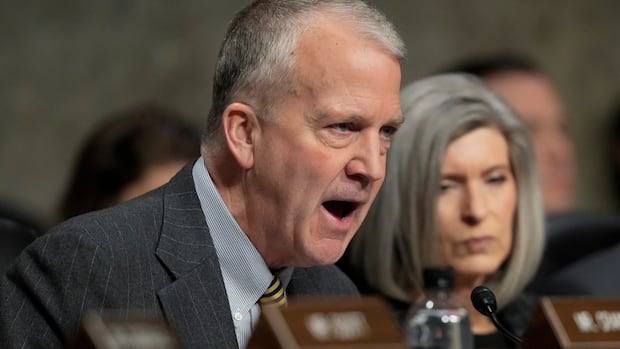At a café in the heart of a swing county in the largest of the American swing states, no music played the morning after the presidential election. The Lawrence Park Dinor in Erie, Pa., heard only conversation between bleary-eyed customers absorbing the night’s stunning result over coffees and breakfast.
Those who had thrown their support behind the Republican president-elect felt joy, relief and a touch of vindication. Their Democratic counterparts were visibly dazed.
- Do you have a question about the U.S. election result? Or what a second Trump term will look like? Send an email to ask@cbc.ca.
“I didn’t think I was going to come to the diner because I was, until 40 minutes ago, in bed crying watching the news. I just cannot believe how this played out,” said Robin Westcott, a retired college admissions co-ordinator in her mid-60s.
Sitting across from her husband, she said she was already looking to 2028: “I will start working with the Democratic Party again to figure out what went wrong and work towards the next election and have a better message.
“Hopefully they’ll find a good candidate [next time]. It will probably have to be a white male, which irritates the crap out of me, but what can you do.”
In Erie County, Pa., reaction was mixed after Donald Trump’s decisive win in the presidential election, with some voters expressing optimism over his expected policies and others struggling to process how the election played out.
Donald Trump sailed to victory over Democratic presidential candidate Kamala Harris on Tuesday after seizing a slate of reliably red states and sweeping all of the seven critical battlegrounds. By early Wednesday morning, Trump had secured 279 electoral votes to Harris’s 223.
Trends from exit polls are very preliminary findings that can — and will — evolve over time, but have so far shown that Harris did get the usual Democratic advantage among women, but three points less than what President Joe Biden got in 2020. Trump, meanwhile, saw narrow gains among both men and women.

During the antagonistic race for the White House, both candidates tried to turn the gender gap among voters to their advantage — with Harris focusing on reproductive freedom as a cornerstone of her campaign and Trump doubling down on a hypermasculine strategy to draw more men to the polls.
But it wasn’t enough for Harris, who had been hoping a wave of female support would carry her Washington, and she underperformed Biden’s results in many states.
A tall order
Harris, the eldest daughter of an Indian mother and Jamaican father, has already risen higher in U.S. leadership than any other woman in its history, as vice-president.
The only other woman to get nearly as close was former senator Hillary Clinton, who lost to Trump in 2016. She rooted her candidacy in part on her potential to break “herstory” as the first female president, leaning into “I’m With Her” merchandise and denouncing her opponent’s misogynistic, sexist behaviour in her 2016 campaign.
Harris adopted the opposite strategy. Close aides and advisers told Reuters she resisted putting her identity at the centre of her campaign. She instead leaned heavily into issues most likely to galvanize the Democratic base, including protecting reproductive rights, ending gun violence and strengthening the middle class that raised her in West Berkeley, Calif.
Trump appealed to male voters with a populist message and with podcast appearances, a strategy which culminated in an election-eve endorsement from one of the medium’s largest stars: the comedian, actor and UFC commentator Joe Rogan.
“[Trump’s] message being sent to young men was, ‘I see you, I care about you and the other side thinks you’re all toxic,'” Jackson Katz, the documentarian behind The Man Card: 50 Years of Gender, Power & The American Presidency, told NPR on Wednesday.
“Some of our hope was that the Kamala Harris campaign and the pick of Gov. Tim Walz was going to be responsive to that and more aggressive in their outreach to young men, and obviously that fell short.”
Overcoming a history of gender, race discrimination
The big question of Harris’s campaign was whether she could overcome the long history of racial and gender discrimination in the U.S., as a biracial woman.
In 248 years, the United States has only elected one president who wasn’t a white man: Barack Obama in 2008 and 2012.
Trump used Harris’s identity as a personal attack during the campaign, accusing her of only identifying as Black when it was politically advantageous to do so. Harris made it clear that her opponent was the one bringing her identity into the mix, calling it “the same old show of divisiveness and disrespect.”
In an interview with NBC last month, she dismissed the idea that sexism could harm her chances: “I will never assume that anyone in our country should elect a leader based on their gender or their race.”
In her first address after losing the 2024 U.S. presidential election to Donald Trump, Democratic candidate Kamala Harris thanked her supporters and emphasized that there will be a peaceful transfer of power.
Cost of living remained top concern
In the end, Harris did not connect with voters, frustrated by the cost of living under the historically unpopular Biden administration with which she is inextricably linked.
And despite access to abortion being a motivator for many liberal American voters, the issue didn’t turn into widespread support for the Democrats. In fact, some states passed ballot measures on Tuesday making it legal again or strengthening protections for it, but still voted Trump in the federal election.
The cost of living was Trump’s strongest draw for voters, bringing in people who didn’t even like the candidate personally.
“I’m just excited to be able to see that Trump got his presidency,” said Dan Young, a Trump voter from northeast Pennsylvania whose wife woke him up with the results on Wednesday.

“I think it’s going to be a good thing.… I think everything’s going to get back on the right track and the needed changes are going to be happening. Our economy is a complete disaster.”
Sitting across from her husband at the diner in Erie, Pa., Westcott said Harris’s loss cut deeper than Clinton’s did four years ago. She said she thought Trump’s two impeachments, four criminal indictments, his handling of the COVID-19 pandemic, ongoing falsehoods and increasingly inflammatory campaign rhetoric would’ve made a difference this time.
“It’s a different kind of shock.”












